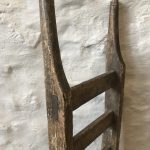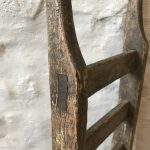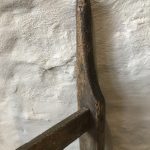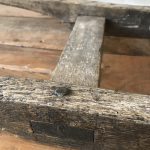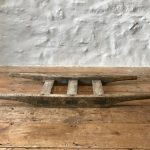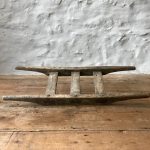A rare Welsh hand barrow, made from ash. Used from carrying produce or goods over hilly or uneven ground. This is a well used example and has much wear and evidence of old woodworm.
Provenance from The Museum of the Home, Pembroke.
34½” long x 13” deep x 3½” high / 87.6cm long x 33cm deep x 9cm high
£345 Sold
….The simplest of all the carrying devices that has persisted to this day in Britain is the hand barrow, a vehicle similar to the funeral bier. This consists of two parallel pieces of timber, joined together by a number of cross-pieces which form the carrying surface. The barrow was designed for carrying by two men and was widely used in the nineteenth century, particularly in hilly or marshy districts where no animal-drawn vehicle could go. In the Llanuwchllyn district of Merionethshire, for example, all dung was carried to the upland fields in hand barrows no more than a hundred years ago. Each farm in that mountain-locked locality specified a day for maturing its fields, and on that day neighbouring farmers and their families met at the specified farm with a large number of barrows. The carrying was performed in a relay service, the barrow changing hands many times before it reached the upland fields. Hand barrows may still be seen in use in hilly districts, particularly in those areas where peat harvesting is still an essential annual occurrence…
From ‘Life and Tradition in Rural Wales’ by J Geraint Jenkins 1976.








